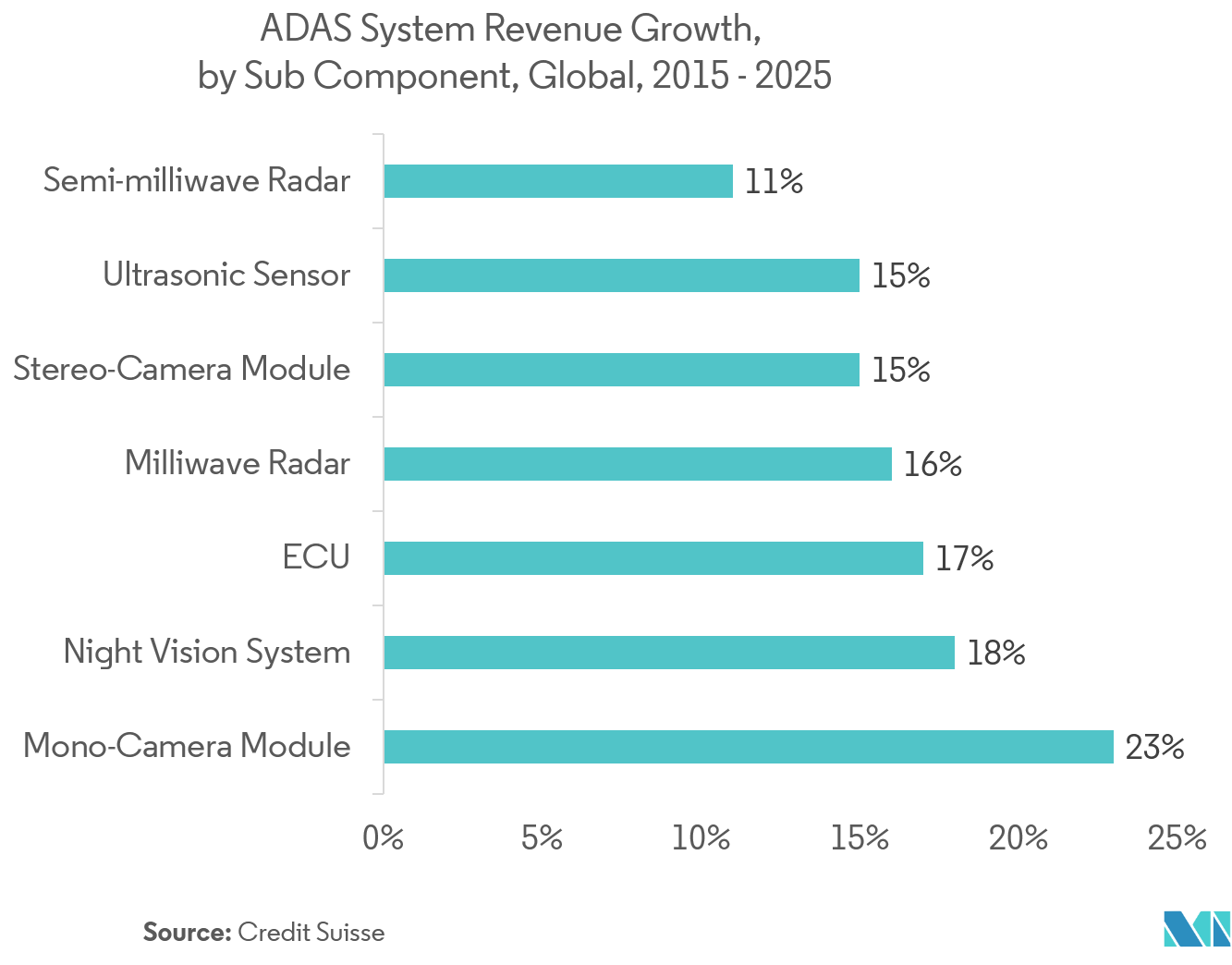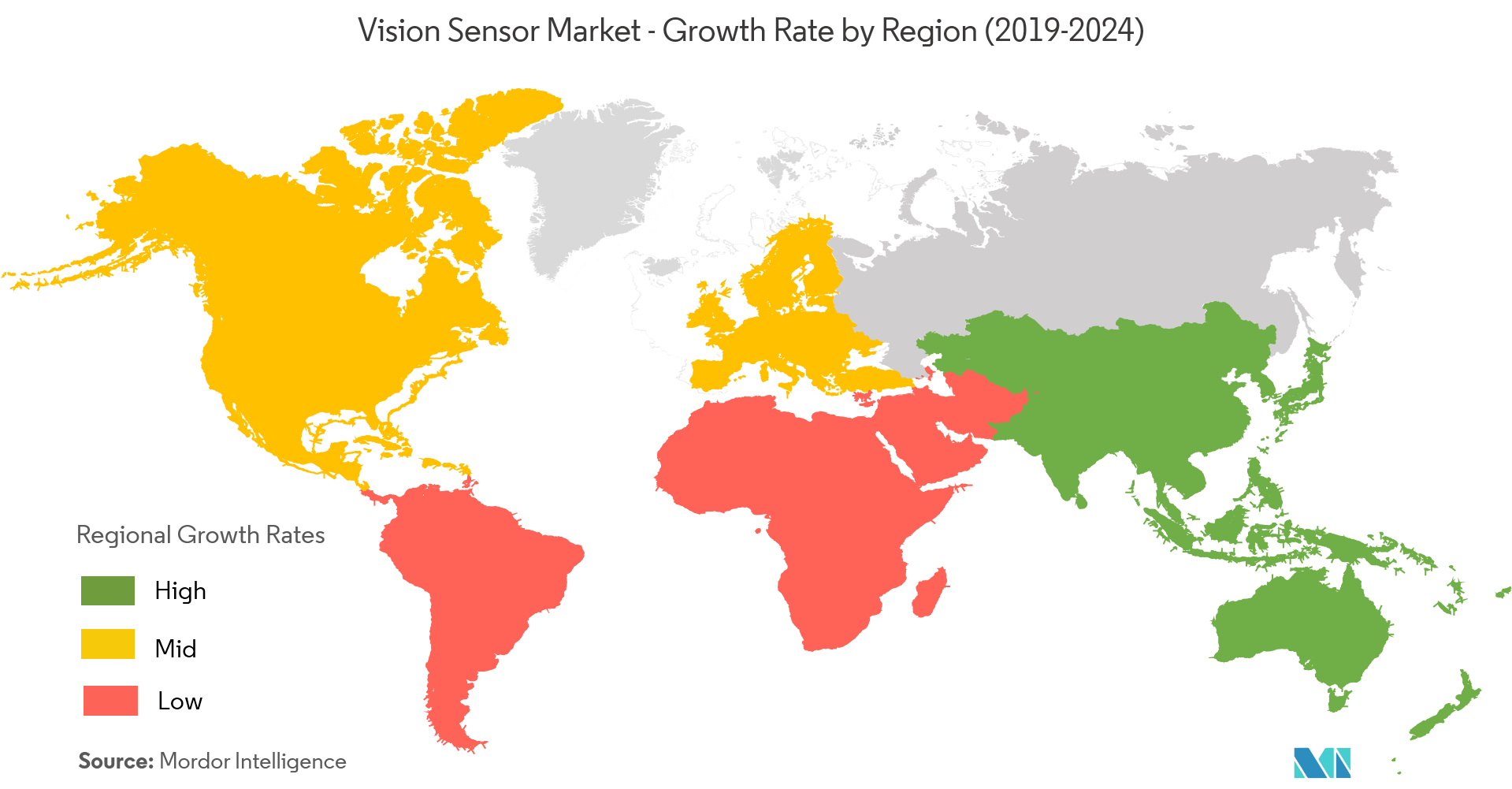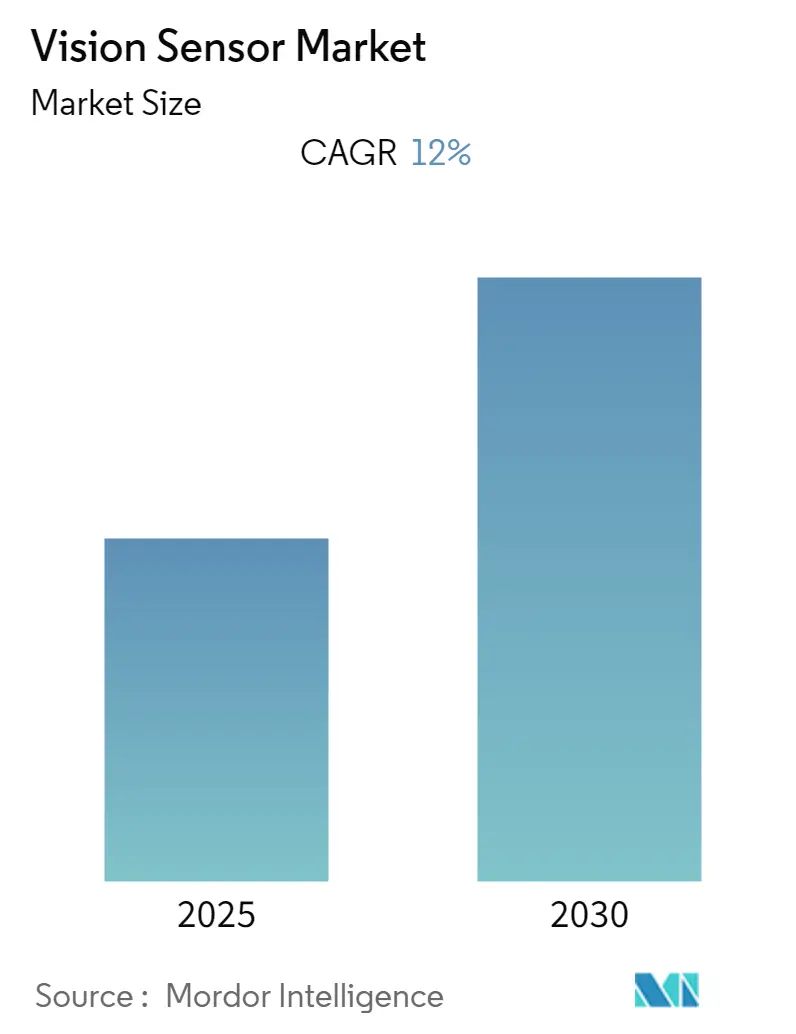
| Study Period | 2019 - 2030 |
| Base Year For Estimation | 2024 |
| Forecast Data Period | 2025 - 2030 |
| CAGR | 12.00 % |
| Fastest Growing Market | Asia Pacific |
| Largest Market | North America |
| Market Concentration | Low |
Major Players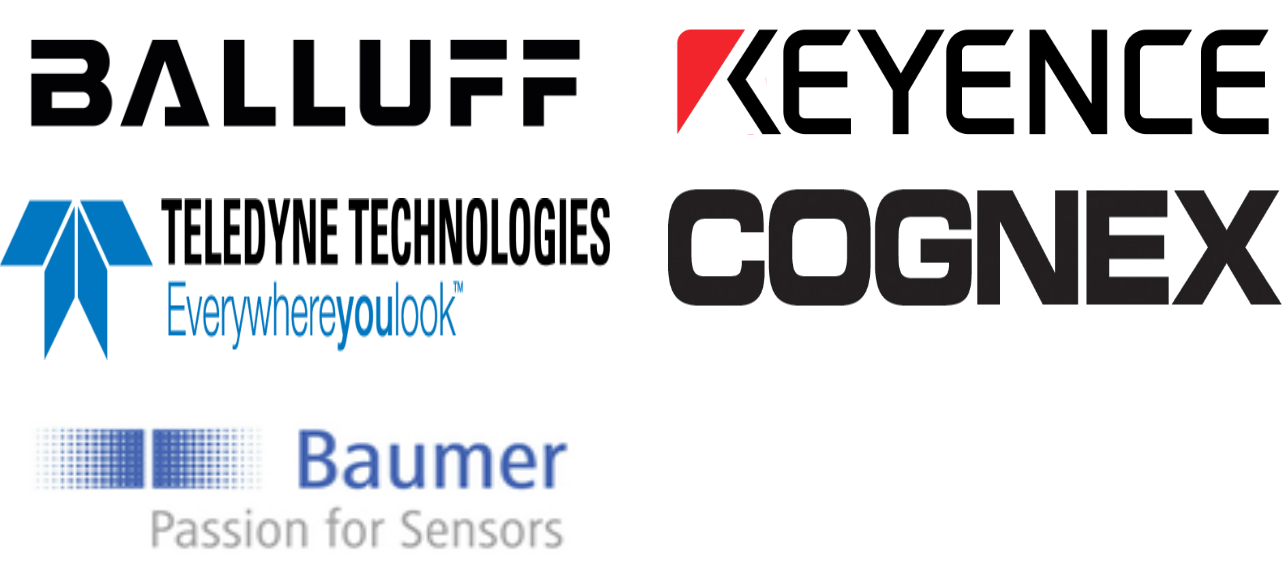
*Disclaimer: Major Players sorted in no particular order |
Vision Sensor Market Analysis
The Vision Sensor Market is expected to register a CAGR of 12% during the forecast period.
- The vision sensor market is proliferating, owing to the rising product demand by various enterprises and the industrial sector. The factors responsible for the growth of the vision sensors market are growing electronics and electrical industry along with rising demand for consumer electronics.
- There is a high demand for vision sensors for part detection as well as measurement in the automotive industry.
- Furthermore, rapidly growing advanced automation technology, owing to the significant usage of vision for automation in the products manufacturing over the forecast period.
- There is high product innovation in vision sensors, such as working capabilities in harsh conditions. Retail and consumer goods industry is on significant growth wherein the demand for vision sensors for bar code scanning is increasing rapidly.
- However, higher development, installation cost, and high labor cost might negatively impact the market growth.
Vision Sensor Market Trends
Automotive Expected to Hold Significant Growth
- The automotive industry is expected to have significant demand for vision sensors owing to the increasing demand for these sensors in identification, inspection, and localization applications. Examination of various parts and components, identification of faulty components, misalignment of parts and components, and guiding robotic arms to perform complex tasks on the assembly line will be some of the critical applications that will boost the demand for vision sensors from this industry.
- Industrial digitalization is considered as one of the essential criteria for optimizing the manufacturing processes of robots, industrial machines, and processing set-ups.
- DENSO Corporation, a global automotive components manufacturer, headquartered in the city of Kariya, Japan, has developed a small stereo vision sensor which improves the safety of compact vehicles. The sensor is the world’s smallest automotive stereo vision sensor and is used in Smart Assist III, a crash avoidance system designed for the new Daihatsu Tanto.
- Robust yet easy-to-use self-contained vision sensors perform automated inspections that previously required costly and complex vision systems. The most popular vision sensors will be in smart cameras, which are often used in vehicle recognition technologies. However, vision sensors are also used across various industrial sectors to monitor processes and ensure product quality.
Asia-Pacific Expected to Witness Significant Growth
- Asia-Pacific region is expected to hold significant growth for vision sensors. Major factors driving the growth of the vision sensors in Asia-Pacific region include the increase in spending on industry automation to reduce manufacturing costs, minimize time to market, and improve quality standards across different end-user industries such as automotive, electronics, food & beverages, and packaging.
- The pharmaceuticals, automotive, food & packaging industries in the region are having significant growth in the past few years. These have been fueled by the huge population shift and an increase of disposable income, which has prompted a higher demand for products in the region.
- Manufacturers are looking to adopt automation techniques in manufacturing to reduce costs, save time, and improve product quality. These factors will continue to push the demand for vision sensors in these industries in the APAC region during the forecast period.
Vision Sensor Industry Overview
The vision sensor market is fragmentedwith several sensormanufacturers, as they strive to maintain a competitive edge in the market, thereby intensifying the competition in the market. Various innovations are taking place in the market, thus enhancing the growth of the vision sensor market.
- Oct2018 - Baumer launched its new CMOS-based GigE and USB 3.0 CX series of polarization cameras which exploit the polarization properties of light, enabling a variety of new industrial image processing applications, such as quality control of glass, carbon fiber fabric (CFRP), or reflective surfaces.
- Sept2018 - Sick AG introduced its Visionary-T DT sensor. It is a 3D vision sensor that uses single-snapshot time-of-flight (TOF) technology to detect the presence or absence of 3D objects. With a sensing range of up to 50 by 45 meters at 40 meters distance, Visionary-T DT is ideal for collision warning systems on forklifts, automated guided vehicles (AGV), and carts (AGC).
- Jul2018 - Keyence launched a new IV-H series of vision sensors that increases the stability and functionality of visual inspection. The new IV-H series of vision sensors are expected to typically replace multiple sensors for an all-in-one solution for applications with various parts to detect.
Vision Sensor Market Leaders
-
Cognex Corporation
-
Teledyne Technologies
-
Keyence Corporation
-
Baumer Holding AG
-
Balluff GmbH
- *Disclaimer: Major Players sorted in no particular order
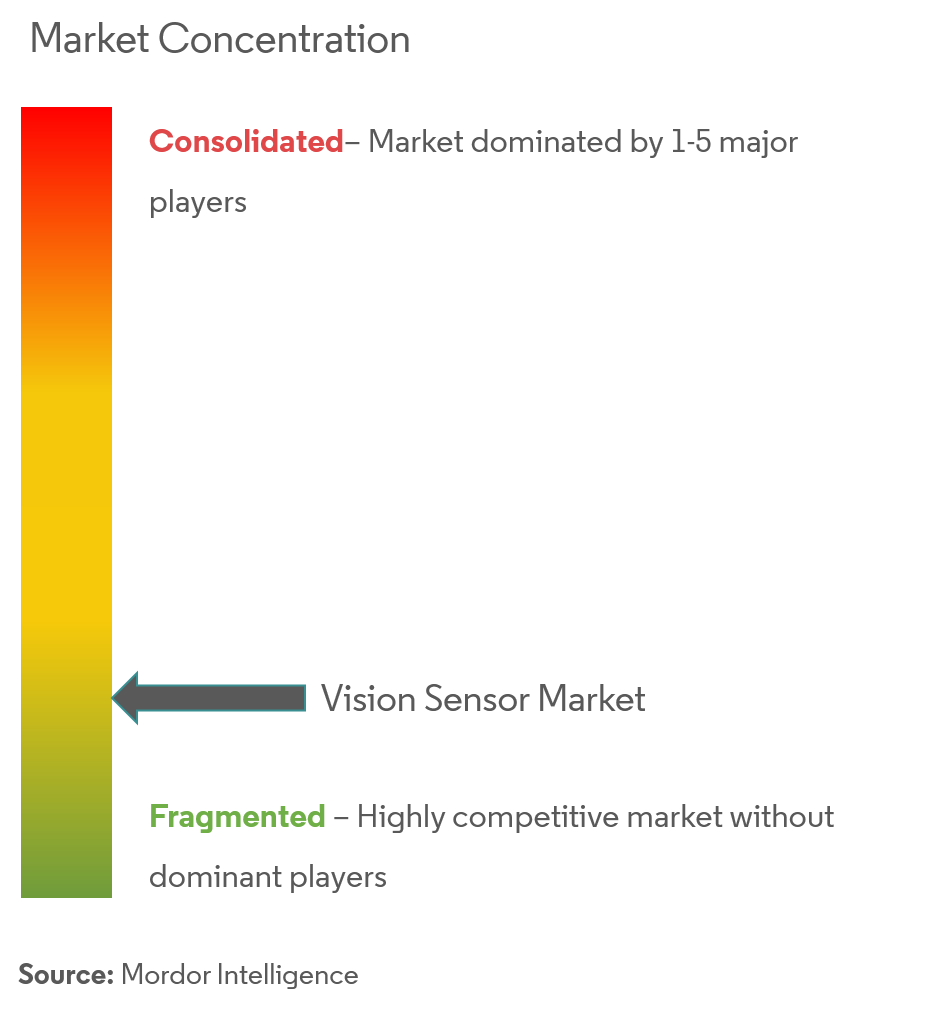
Vision Sensor Industry Segmentation
Vision sensors consist of the interface, display, video camera, and the computer processor, which help to automate industrial processes. The vision sensors are used to determine the orientation, presence, and accuracy of the elements with the help of an image captured by the camera. They differ from image inspection "systems" in that the camera, light, and controller are contained in a single unit, which makes the unit's construction and operation simple. These are mostly used for measurement and other observable characteristics regarding product quality. These are integral parts of manufacturing that help to increase efficiency.
| By Application | Inspection | ||
| Gauging | |||
| Code Reading | |||
| By End-user Industry | Automotive | ||
| Consumer Electronics | |||
| Electrical & Electronics | |||
| Pharmaceutical | |||
| Food & Beverages | |||
| Other End-user Industries | |||
| Geography | North America | United States | |
| Canada | |||
| Europe | United Kingdom | ||
| Germany | |||
| France | |||
| Italy | |||
| Rest of Europe | |||
| Asia-Pacific | China | ||
| Japan | |||
| South Korea | |||
| India | |||
| Rest of Asia-Pacific | |||
| Rest of the World | Latin America | ||
| Middle-East & Africa | |||
Vision Sensor Market Research FAQs
What is the current Vision Sensor Market size?
The Vision Sensor Market is projected to register a CAGR of 12% during the forecast period (2025-2030)
Who are the key players in Vision Sensor Market?
Cognex Corporation, Teledyne Technologies, Keyence Corporation, Baumer Holding AG and Balluff GmbH are the major companies operating in the Vision Sensor Market.
Which is the fastest growing region in Vision Sensor Market?
Asia Pacific is estimated to grow at the highest CAGR over the forecast period (2025-2030).
Which region has the biggest share in Vision Sensor Market?
In 2025, the North America accounts for the largest market share in Vision Sensor Market.
What years does this Vision Sensor Market cover?
The report covers the Vision Sensor Market historical market size for years: 2019, 2020, 2021, 2022, 2023 and 2024. The report also forecasts the Vision Sensor Market size for years: 2025, 2026, 2027, 2028, 2029 and 2030.
Our Best Selling Reports
Vision Sensor Industry Report
Statistics for the 2025 Vision Sensor market share, size and revenue growth rate, created by Mordor Intelligence™ Industry Reports. Vision Sensor analysis includes a market forecast outlook for 2025 to 2030 and historical overview. Get a sample of this industry analysis as a free report PDF download.



